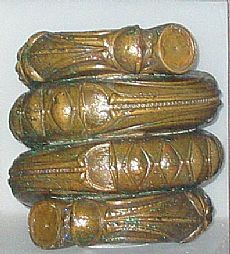Snake armring from Culbin Sands
05 July 2013
- News Type:
- Find of the Month
 This bronze armring was found at Culbin Sands between Nairn and Findhorn, and dates to the first centuries BC. It depicts a coiled double-headed snake whose eyes are created with blue glass. It was cast in straight rods, decorated in part with ribbing or grooves, with animal heads at the ends. The rods were then coiled into spirals.
This bronze armring was found at Culbin Sands between Nairn and Findhorn, and dates to the first centuries BC. It depicts a coiled double-headed snake whose eyes are created with blue glass. It was cast in straight rods, decorated in part with ribbing or grooves, with animal heads at the ends. The rods were then coiled into spirals.
Eight bracelets of this type are known, all but one from Scotland, with most of these from the north-east. A similar, but much more worn, example was found in peat at Duntulm on Skye. These bracelets would have been worn to show power and status, though whether they were for men or women remains a matter of speculation. Some believe that the spiral bracelets were worn by women, whereas the so-called massive metalwork armlets, such as that from Achavrail in Sutherland, are bigger, and therefore attributed to men. Many other high status objects from the Iron Age and other periods were found at Culbin Sands.
Both the Culbin Sands and Duntulm armrings are in the National Museums of Scotland in Edinburgh. This object featured in ARCH’s Display the Past project which looked at the archaeology of Culbin Sands in 2011.
Further information:
SCRAN website: Culbin Sands armring id 000-100-036-182-C. Duntulm arming id 000-100-104-097-C
Hunter, Fraser 2006. ‘New Light on Iron Age massive armlets’, Proceedings of the Society of Antiquaries of Scotland 136, pp. 135-160. Available on-line
Find of the Month Archive
- 25/07/2022 Steatite Vessels
- 10/04/2021 Cruisie lamp in Dunrobin Castle Museum
- 02/03/2021 Medieval Sword Pommel from Sleat, Skye
- 01/02/2021 Hilton of Cadboll Pictish Cross Slab
- 04/01/2021 Gunflint from Stoneyfield, Inverness
- 02/12/2020 Bobbin from Contin Bobbin Mill
- 02/11/2020 Russian Lead Cloth Seal from Cromarty
- 01/10/2020 The Poolewe Hoard
- 04/09/2020 Storr Rock Viking Silver Hoard
- 07/08/2020 Mesolithic bloodstone artefacts from Camas Daraich, Skye
